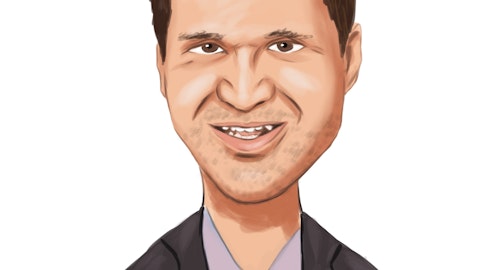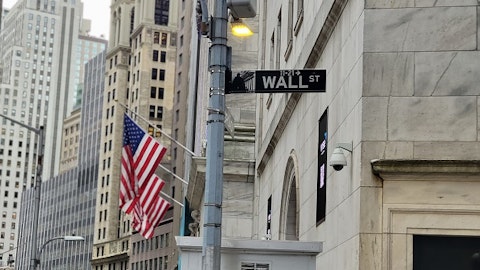WSFS Financial Corporation (NASDAQ:WSFS) Q3 2023 Earnings Call Transcript October 24, 2023
Operator: Hello and thank you for standing by. My name is Regina and I will be your conference operator today. At this time, I would like to welcome everyone to the WSFS Financial Corporation Third Quarter 2023 Earnings Conference Call. All lines have been placed on mute to prevent any background noise. After the speakers’ remarks, there will be a question-and-answer session. [Operator Instructions]. I’d now like to turn the conference over to your host for today, Mr. Art Bacci, Chief Wealth Officer, Interim Chief Financial Officer. Sir, you may begin.
Arthur Bacci: Thank you, Regina. Good afternoon and thank you again for joining our third quarter 2023 earnings call. Our earnings release and earnings release supplement, which we will refer to on today’s call, can be found in the Investor Relations section of our company website. With me on this call are Rodger Levenson, Chairman, President and CEO, and Steve Clark, Chief Commercial Banking Officer. Before I turn over the call to Roger for his remarks on the quarter, I would like to read our Safe Harbor statement. Our discussion today will include information about our management’s view of our future operations, plans and prospects that constitute forward-looking statements. Actual results may differ materially from historical results or those indicated by these forward-looking statements due to risks and uncertainties, including, but not limited to, the Risk Factors included in our annual report on Form 10-K and our most recent quarterly reports on Form 10-Q, as well as other documents we may periodically file with the Securities and Exchange Commission.
All comments made during today’s call are subject to this Safe Harbor statement. I will now turn the call over to Roger.
Rodger Levenson: Thank you, Art, and everyone else for joining us on the call today. WSFS performed very well in the third quarter as we continue to demonstrate the strength and diversity of our business model. Core EPS of $1.23 and core ROA of 1.46% represented growth from the second quarter of 6% and 4%, respectively. Our performance was driven by loan growth across all our commercial and consumer segments. Deposits were essentially flat when compared to the second quarter, excluding the anticipated runoff of short-term transaction-related deposits in our corporate trust business. The net interest margin remained very solid at 4.08%, reflecting the impact of the Fed hike in short term rates in July, expected increase in deposit betas and very modest deposit attrition.
Through-the-cycle interest-bearing deposit betas ended the quarter at 39% as the pace of growth continued to moderate. NIM was favorably impacted by about 5 basis points due to higher purchase loan accretion and maturity events in a few reverse mortgages. Core fee revenue grew 9% linked quarter and was a record quarterly high. Growth came from each of our major business lines including wealth and trust, Cash Connect, mortgage banking, capital markets, and the core banking business. The core fee revenue ratio increased to 28.60%. Consistent with the slowing economy and corresponding credit normalization, we did see a negative uptick in our asset quality metrics. Most of this variance was driven by two unrelated C&I credits that moved to non-performing status due to operating challenges specific to those businesses.

A bank teller counting and sorting cash in a modern, well-lit office. Editorial photo for a financial news article. 8k. –ar 16:9
Problem asset migration reflected downgrades in the commercial sectors, including office. Inclusive of these downgrades, the office loan portfolio has 6% problem loans, zero delinquency and less than $1 million in NPAs. Total classified loans to Tier 1 capital plus ACL stood at 16.11% or just under 3% of total loans. Credit losses were relatively flat to Q2 at 45 basis points or 19 basis points excluding NewLane leasing and Upstart portfolios. Our balance sheet remains strong, including significant liquidity capacity and regulatory capital levels that continue exceed well capitalized. On slide 14 of the earnings release supplement, we have provided an update to our mid-year 2023 outlook, incorporating Q3 results and commentary on Q4 ranges on NIM, PPNR, and ROA percentages.
Overall, we remain on track to achieve the full-year outlook, which assumes no additional short term rate hikes and modest GDP growth in Q4. Consistent with our historical practice, we will provide a 2024 outlook when we announce Q4 earnings in late January. Thank you. And I will now turn it back to Art to facilitate the Q&A.
Arthur Bacci: We will now open the line to answer any questions you may have.
See also 10 Tax Free Retirement Countries for US Citizens and 20 Most Bicycle-Friendly Countries in the World.
Q&A Session
Follow Wsfs Financial Corp (NASDAQ:WSFS)
Follow Wsfs Financial Corp (NASDAQ:WSFS)
Operator: [Operator Instructions]. Our first question will come from the line of Frank Schiraldi with Piper Sandler.
Frank Schiraldi: I want to ask about the loan growth here. Obviously, quite strong in the quarter. You reiterated your guide overall for 2023. But as we start to think about – you guys have – particularly given your low loan-to-deposit ratio, but also we’re seeing maybe a tougher credit environment. So, how do you think about the opportunity versus potential risk here? Do you think we start to see some moderation in this loan growth going forward here? What are your thoughts in general?
Stephen Clark: Frank, this is Steve Clark speaking. So, I think the way we look at the loan growth is really about opportunity in the current macroenvironment and the current region we serve. So, on CRE, we continue to be very, very selective. We have focused on multifamily and residential, particularly at the beach and shore markets. But the real opportunity for us is C&I. That pipeline is relatively strong. It’s the result of some of our competitors being distracted and some of the service issues companies are experiencing from their incumbent banks. So that creates opportunity for us. So we’re very active in CNI calling and prospecting, very selective in CRE, but do have a tailwind of fundings coming from commitments that were extended last year and were underwritten in a higher rate environment and very sensitized to the rate environment. So that’s kind of my perspective.
Frank Schiraldi: Just on credit, I think the coverage ratio, reserve coverage ratio was flat linked-quarter. Just given some of the downgrades on the problem assets, could you just maybe speak to that a bit? And was this credit migration kind of baked into the reserve already or just your general thoughts on reserving and the credit migration, particularly on the problem asset side?
Arthur Bacci: Frank, this is Art. The ACL was flat at 1.28%. Remember, a good portion of that was because of just loan growth. So that was less impacted by any migration issues. This is something we will continue to evaluate throughout the quarter as we look at the economic outlook and the trends we’re seeing. But at this point, we feel pretty comfortable with the coverage ratio where it is.
Stephen Clark: This is Steve. I would only add that the credit migration you referenced is – those assumptions are baked into the current ACL from both a qualitative and quantitative perspective.
Frank Schiraldi: If I could just sneak in one last one on the deposits. You guys mentioned the trust deposits that flowed back out, the transactional stuff. And I guess that was a driver of the non-interest bearing balances being down linked quarter. Just any thoughts on what you’re seeing more generally there. Do you expect kind of a continued flow of leads in non-interest bearing balances in this kind of higher for longer rate environment?
Arthur Bacci: This is Art. I’ll take that. When you look pre-COVID, our non-interest bearing total deposits was around 27%, 28%. We’re at about 31% now. So we’re still above where we were pre-COVID. There may be a little bit more leads to go there, but I think we’re kind of towards the bottom of it. On the trust deposits, there’s an element of it that – there’s really two components of our trust deposits. One is kind of a, I’d call it, right now $700 million to $800 million base that’s just recurring cash flow coming in from loan payments that we pass on to investors. Then there’s a component where there may be certain types of trusts that are pre-funded with cash and we hold for a period of time. That’s the lumpy component of it.




